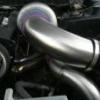I was chatting to Nakkers today about the R32 and I remembered an R32 from many years ago and told him about it. I went searching and found the following:

HKS R32 Zero-R
Started by 2LV8ETR, Jul 02 2010 01:03 PM
#1

 Posted 02 July 2010 - 01:03 PM
Posted 02 July 2010 - 01:03 PM

#2

 Posted 02 July 2010 - 01:04 PM
Posted 02 July 2010 - 01:04 PM

From the March, 2009 issue of Turbo & High-Tech Performance - http://www.turbomaga..._r32/index.html
2006 is the year of a true comeback. The extremely rare, limited edition BNR32-based HKS Zero-R has been re-released sporting a fully re-engineered engine, transmission and suspension. Could this be the ultimate street-going GT-R? The history of this unique car starts back in the early '90s when HKS' headquarters in Japan decided to do what tuning shops such as RUF where doing in Germany, and that is create bespoke high-performance streetcars. The project started with four cars being built. However, when the time came to register them as one-off models not tied with the Nissan brand, the problems began. Due to Japanese legislation at the time, HKS was required to crash test a number of cars in order to obtain road homologation. HKS decided to abandon the project as it would have proven too expensive, totaling 13,000,000 ($116,400) per car. In the end, HKS kept three of the cars. The fourth was purchased by the Sultan of Brunei, who had it shipped home to join his extensive collection of exotic cars.
It wasn't until last year that HKS decided to bring back the Zero-R. This was possible thanks to slightly more lax legal procedures that would allow HKS to register the car as a modified Nissan Skyline R32 GT-R. When HKS announced this via a small feature article in an issue of the Japanese GT-R Magazine, the phone calls began. The job of bringing the car back into life, and of creating it in line with modern performance expectations, was given to HKS Technical Factory in Tokyo. As Mr. Kikuchi, president of the workshop explains, the 450PS and 50 kgm developed by the original cars just wasn't going to cut it in today's market. The now obsolete TA45S single turbine needed to be replaced and every other technical aspect of the car looked at in order to guarantee the best possible result.
The silver car you see here is the first Zero-R to be registered in Japan, now owned by a GT-R-crazy doctor in Kobe. This was the first of the three cars HKS had left to be converted into "modern-day" specifications. It all started with the engine. The old RB26 was scrapped and replaced by the finest performance parts currently available. Basing the build on a limited edition Nismo GT-block, it was already bored to accept the fully forged and balanced HKS 2.8-liter kit. Thus the final product would guarantee ample durability and strength seeing that this block was the same thick-walled item used on all RB powered GT-500 race cars from the JGTC championship (now called Super GT).
The extra 200cc in capacity would help achieve the goal of creating a motor that is powerful but responsive, with bucket loads of torque at any rpm. Compression was slightly increased to 8.7:1 while a lot of work went into preparing the head for optimal breathing performance, with fully ported and polished intake and exhaust ducts as well as full HKS valvegear. For best real-world performance it was decided to use the recently released HKS V-Cam System, which introduces programmable variable valve timing on the intake side. As both drivability and durability were the main objectives for HKS, it was decided to use a set of GT2530 turbines. These allow the Zero-R to crank out 600 PS at 7,400 rpm, and - thanks to the combined hike in capacity and V-Cam System - a mighty 66 kgm at 4,400 rpm. These are figures GT-R owners would have only dreamt about 10 years ago, especially if you take into account the progressive power delivery and virtually flat torque curve from 3,000 rpm all the way to 6,000 rpm.
Juggling all this twisting force is a Nismo Coppermix clutch, which is as easy to use as a stock factory unit and sends drive to the Getrag 6-speed transmission. No, that's not a misprint - HKS has replaced the Nissan 5-speeder with the BNR34 box. The final drive is now 3.9, and is perfectly matched for the electrifying performance of the revamped RB.
Sitting in the HKS factory for over 10 years can take its toll on the suspension. With this in mind, HKS stripped down every component from under the car - including the sub-frames, and replaced all bushings, links and suspension arms - with Nismo parts. This sharpened up the steering and the handling to offer a more aggressive geometry; and will work beautifully for days at the local circuit. A special custom version of the HKS Hyper Max II coilover kit was fitted specifically for the Zero-R. Braking needed to be addressed too, as the old AP Racing calipers, although still pretty good, just didn't offer the same performance as modern set-ups. So in went 6-pot AP Racing calipers at the front, while the rear is balanced with some 4-pots - again from AP Racing. These both bite down on grooved discs with Performance Friction pads.
The exterior of the Zero-R has been left untouched - a testament that the original BNR32 design has stood up to the test of time. Within the dress-up, the Zero-R sports a complete body conversion made up of a vented front bumper, chunky side skirts and an aggressive rear-end - courtesy of the twin-exit exhaust system, which peeks its thick tail pipes out of a vented shroud. The exhaust is, in fact, the reason why the Zero-R has no rear seats. Since a lot of space was needed to somehow fit the two rear silencers, the fuel tank was removed and custom mounted where the stock rear seats would be. This might not be such a great idea, as you are actually putting a great deal of weight high up in the car's chassis. However, there is no arguing that the rear end conversion looks superb. The original Italian Tecnomagnesio wheels were specially designed and built for the Zero-R; so the owner decided to keep them on, albeit ten years later, for the complete look. The interior has been mostly left untouched, aside from the rear fuel-tank enclosure.
On the original Zero-R, two reclining Recaro seats replaced the stock items. However, on this particular car the owner has just fitted a BNR34 seat on the driver side, which he is trying out for a bit before making his final selection on seat choice. Ahhh, must be nice to have money. Gauge-wise, the 360 km/h rated speedo and other meters have been left untouched; and are now joined by a host of modern toys like a set of Defi gauges, the HKS Black Limited EVC boost controller, HKS torque split controller and the HKS V-Cam unit. To keep an eye on Kobe's traffic, an Alpine hard-disk navigation system takes center stage in the interior; while small details like the HKS shift knob and HKS Zero-R original steering wheel finish things off.
But, no matter how many promises and talk of numbers or power curves, there is nothing like taking a car for a drive to find out what it's really like. Could this be the ultimate street GT-R? Wishing to find an answer we kindly accepted the keys to the Zero-R from Mr. Kikuchi, who let us take the car for a very memorable drive. It's special to drive a Zero-R: there are only two on the road in Japan, and the latest modifications have transformed it into a spectacular ride. As with every 2.8-liter GT-R, you feel the extra capacity the instant you get on the gas. The engine feels gutsier and more willing to pull at lower rpm. But, the Zero-R has a few tricks up its sleeve thanks to the V-Cam. This little gadget maximizes engine breathing continuously, boosting power and torque at every engine speed; but it's from 2,500 rpm and 6,500 rpm that you really feel it work.
GT2530s might be one of the smallest turbine kits you can put on an RB26; but on a 2.6-liter engine without variable valve timing, they always feel very laggy until about 4,500 rpm when they begin to generate some real boost. On the Zero-R they come into play at 3,000 rpm with well over 1 bar of boost available. Out on the streets, this translates to immediate acceleration no matter what gear you're in. But it's when you really tap into those 600 PS that the Zero-R begins to fly. Despite the maps on the HKS F Con V-Pro not being fully refined yet, there is an impressively smooth and unrelentless power delivery. Needless to say, 600 PS is a hell of a lot of power; and it's almost comical when you look at the needle on the speedometer rise. The BNR34 Getrag transmission feels just perfect with a nice and tight shift pattern making the best of all the engine's capabilities. The AP Racing brakes offer a strong bite at any speed, just make sure you look in the rearview mirror before jumping on them.
HKS has definitely made one of the most impressive GT-Rs out there. Sure there are more powerful ones, but finding such widespread electrifying performance is not as easy. Having accessible power in any gear and at any speed is precisely what makes the Zero-R such an exhilarating drive. The most ultimate GT-R ever? We certainly think so.
Specs
HKS zero-rMax Power: 600 PS @ 7,400 rpm
Engine
Nismo GT Block
HKS 2.8 L kit (forged pistons, H-type conrods, crank)
HKS metal head gasket
HKS oil pump
Ported and polished head
HKS V Cam System for intake cam
Nismo GT intake plenum
HKS GT2530 turbines x2
HKS actuators
HKS complete piping kit
HKS SPF filters
HKS R-type intercooler
HKS front pipes
HKS sports catalizer
HKS Zero-R special twin exit exhaust system
Large core Koyo radiator
HKS Zero-R green engine covers
HKS F-Con V Pro (airflow-less)
Transmission
Nismo Copper mix clutch
BNR34 stock Getrag 6-speed transmission
3.9 final gear
Suspension & Brakes
HKS Hyper Max II Zero-R SPL
Nismo front & rear circuit links with stiffer bushes
HKS Kansai Service front strut tower bar
AP Racing 6-pot front calipers with 355 mm rotor
AP Racing 4-pot rear calipers with 330 mm rotor
Wheels & Tires
Tecnomagnesio 1-piece magnesium-alloy wheels
18"x9" (front & rear)
Yokohama Advan Neova 245/40/18 (front & rear)
Exterior
HKS Zero-R conversion
Front bumper
Front fenders with molded in side skirts
Side aero-skirts
Rear fenders with molded in side skirts, rear bumper and spoiler
Rear bumper with exhaust housing
Rear wing
Zero-R badges
Aluminum fuel cap
Interior
Zero-R custom relocation of fuel tank with custom carpeted
enclosure
Recaro Zero-R Special reclining seats (half leather, half Alcantara)
BNR34 drivers seat (changed by owner)
Zero-R steering wheel
Sablet racing harness
HKS EVC block-limited boost controller
Zero-R main instrumentation
HKS electronic split controller (mounted in glove box)
HKS V-Cam controller (mounted in glove box)
Defi Control Unit II running oil temp., water temp. and oil pressure
gauges (in glove box)
Alpine HDD navigation system
Nismo floor mats
HKS Shift knob
2006 is the year of a true comeback. The extremely rare, limited edition BNR32-based HKS Zero-R has been re-released sporting a fully re-engineered engine, transmission and suspension. Could this be the ultimate street-going GT-R? The history of this unique car starts back in the early '90s when HKS' headquarters in Japan decided to do what tuning shops such as RUF where doing in Germany, and that is create bespoke high-performance streetcars. The project started with four cars being built. However, when the time came to register them as one-off models not tied with the Nissan brand, the problems began. Due to Japanese legislation at the time, HKS was required to crash test a number of cars in order to obtain road homologation. HKS decided to abandon the project as it would have proven too expensive, totaling 13,000,000 ($116,400) per car. In the end, HKS kept three of the cars. The fourth was purchased by the Sultan of Brunei, who had it shipped home to join his extensive collection of exotic cars.
It wasn't until last year that HKS decided to bring back the Zero-R. This was possible thanks to slightly more lax legal procedures that would allow HKS to register the car as a modified Nissan Skyline R32 GT-R. When HKS announced this via a small feature article in an issue of the Japanese GT-R Magazine, the phone calls began. The job of bringing the car back into life, and of creating it in line with modern performance expectations, was given to HKS Technical Factory in Tokyo. As Mr. Kikuchi, president of the workshop explains, the 450PS and 50 kgm developed by the original cars just wasn't going to cut it in today's market. The now obsolete TA45S single turbine needed to be replaced and every other technical aspect of the car looked at in order to guarantee the best possible result.
The silver car you see here is the first Zero-R to be registered in Japan, now owned by a GT-R-crazy doctor in Kobe. This was the first of the three cars HKS had left to be converted into "modern-day" specifications. It all started with the engine. The old RB26 was scrapped and replaced by the finest performance parts currently available. Basing the build on a limited edition Nismo GT-block, it was already bored to accept the fully forged and balanced HKS 2.8-liter kit. Thus the final product would guarantee ample durability and strength seeing that this block was the same thick-walled item used on all RB powered GT-500 race cars from the JGTC championship (now called Super GT).
The extra 200cc in capacity would help achieve the goal of creating a motor that is powerful but responsive, with bucket loads of torque at any rpm. Compression was slightly increased to 8.7:1 while a lot of work went into preparing the head for optimal breathing performance, with fully ported and polished intake and exhaust ducts as well as full HKS valvegear. For best real-world performance it was decided to use the recently released HKS V-Cam System, which introduces programmable variable valve timing on the intake side. As both drivability and durability were the main objectives for HKS, it was decided to use a set of GT2530 turbines. These allow the Zero-R to crank out 600 PS at 7,400 rpm, and - thanks to the combined hike in capacity and V-Cam System - a mighty 66 kgm at 4,400 rpm. These are figures GT-R owners would have only dreamt about 10 years ago, especially if you take into account the progressive power delivery and virtually flat torque curve from 3,000 rpm all the way to 6,000 rpm.
Juggling all this twisting force is a Nismo Coppermix clutch, which is as easy to use as a stock factory unit and sends drive to the Getrag 6-speed transmission. No, that's not a misprint - HKS has replaced the Nissan 5-speeder with the BNR34 box. The final drive is now 3.9, and is perfectly matched for the electrifying performance of the revamped RB.
Sitting in the HKS factory for over 10 years can take its toll on the suspension. With this in mind, HKS stripped down every component from under the car - including the sub-frames, and replaced all bushings, links and suspension arms - with Nismo parts. This sharpened up the steering and the handling to offer a more aggressive geometry; and will work beautifully for days at the local circuit. A special custom version of the HKS Hyper Max II coilover kit was fitted specifically for the Zero-R. Braking needed to be addressed too, as the old AP Racing calipers, although still pretty good, just didn't offer the same performance as modern set-ups. So in went 6-pot AP Racing calipers at the front, while the rear is balanced with some 4-pots - again from AP Racing. These both bite down on grooved discs with Performance Friction pads.
The exterior of the Zero-R has been left untouched - a testament that the original BNR32 design has stood up to the test of time. Within the dress-up, the Zero-R sports a complete body conversion made up of a vented front bumper, chunky side skirts and an aggressive rear-end - courtesy of the twin-exit exhaust system, which peeks its thick tail pipes out of a vented shroud. The exhaust is, in fact, the reason why the Zero-R has no rear seats. Since a lot of space was needed to somehow fit the two rear silencers, the fuel tank was removed and custom mounted where the stock rear seats would be. This might not be such a great idea, as you are actually putting a great deal of weight high up in the car's chassis. However, there is no arguing that the rear end conversion looks superb. The original Italian Tecnomagnesio wheels were specially designed and built for the Zero-R; so the owner decided to keep them on, albeit ten years later, for the complete look. The interior has been mostly left untouched, aside from the rear fuel-tank enclosure.
On the original Zero-R, two reclining Recaro seats replaced the stock items. However, on this particular car the owner has just fitted a BNR34 seat on the driver side, which he is trying out for a bit before making his final selection on seat choice. Ahhh, must be nice to have money. Gauge-wise, the 360 km/h rated speedo and other meters have been left untouched; and are now joined by a host of modern toys like a set of Defi gauges, the HKS Black Limited EVC boost controller, HKS torque split controller and the HKS V-Cam unit. To keep an eye on Kobe's traffic, an Alpine hard-disk navigation system takes center stage in the interior; while small details like the HKS shift knob and HKS Zero-R original steering wheel finish things off.
But, no matter how many promises and talk of numbers or power curves, there is nothing like taking a car for a drive to find out what it's really like. Could this be the ultimate street GT-R? Wishing to find an answer we kindly accepted the keys to the Zero-R from Mr. Kikuchi, who let us take the car for a very memorable drive. It's special to drive a Zero-R: there are only two on the road in Japan, and the latest modifications have transformed it into a spectacular ride. As with every 2.8-liter GT-R, you feel the extra capacity the instant you get on the gas. The engine feels gutsier and more willing to pull at lower rpm. But, the Zero-R has a few tricks up its sleeve thanks to the V-Cam. This little gadget maximizes engine breathing continuously, boosting power and torque at every engine speed; but it's from 2,500 rpm and 6,500 rpm that you really feel it work.
GT2530s might be one of the smallest turbine kits you can put on an RB26; but on a 2.6-liter engine without variable valve timing, they always feel very laggy until about 4,500 rpm when they begin to generate some real boost. On the Zero-R they come into play at 3,000 rpm with well over 1 bar of boost available. Out on the streets, this translates to immediate acceleration no matter what gear you're in. But it's when you really tap into those 600 PS that the Zero-R begins to fly. Despite the maps on the HKS F Con V-Pro not being fully refined yet, there is an impressively smooth and unrelentless power delivery. Needless to say, 600 PS is a hell of a lot of power; and it's almost comical when you look at the needle on the speedometer rise. The BNR34 Getrag transmission feels just perfect with a nice and tight shift pattern making the best of all the engine's capabilities. The AP Racing brakes offer a strong bite at any speed, just make sure you look in the rearview mirror before jumping on them.
HKS has definitely made one of the most impressive GT-Rs out there. Sure there are more powerful ones, but finding such widespread electrifying performance is not as easy. Having accessible power in any gear and at any speed is precisely what makes the Zero-R such an exhilarating drive. The most ultimate GT-R ever? We certainly think so.
Specs
HKS zero-rMax Power: 600 PS @ 7,400 rpm
Engine
Nismo GT Block
HKS 2.8 L kit (forged pistons, H-type conrods, crank)
HKS metal head gasket
HKS oil pump
Ported and polished head
HKS V Cam System for intake cam
Nismo GT intake plenum
HKS GT2530 turbines x2
HKS actuators
HKS complete piping kit
HKS SPF filters
HKS R-type intercooler
HKS front pipes
HKS sports catalizer
HKS Zero-R special twin exit exhaust system
Large core Koyo radiator
HKS Zero-R green engine covers
HKS F-Con V Pro (airflow-less)
Transmission
Nismo Copper mix clutch
BNR34 stock Getrag 6-speed transmission
3.9 final gear
Suspension & Brakes
HKS Hyper Max II Zero-R SPL
Nismo front & rear circuit links with stiffer bushes
HKS Kansai Service front strut tower bar
AP Racing 6-pot front calipers with 355 mm rotor
AP Racing 4-pot rear calipers with 330 mm rotor
Wheels & Tires
Tecnomagnesio 1-piece magnesium-alloy wheels
18"x9" (front & rear)
Yokohama Advan Neova 245/40/18 (front & rear)
Exterior
HKS Zero-R conversion
Front bumper
Front fenders with molded in side skirts
Side aero-skirts
Rear fenders with molded in side skirts, rear bumper and spoiler
Rear bumper with exhaust housing
Rear wing
Zero-R badges
Aluminum fuel cap
Interior
Zero-R custom relocation of fuel tank with custom carpeted
enclosure
Recaro Zero-R Special reclining seats (half leather, half Alcantara)
BNR34 drivers seat (changed by owner)
Zero-R steering wheel
Sablet racing harness
HKS EVC block-limited boost controller
Zero-R main instrumentation
HKS electronic split controller (mounted in glove box)
HKS V-Cam controller (mounted in glove box)
Defi Control Unit II running oil temp., water temp. and oil pressure
gauges (in glove box)
Alpine HDD navigation system
Nismo floor mats
HKS Shift knob

#3

 Posted 02 July 2010 - 01:08 PM
Posted 02 July 2010 - 01:08 PM

Another link from the November, 2006 issue of Turbo & High-Tech Performance - http://www.turbomaga...ro_r/index.html
Here is the picture gallery:
http://www.turbomaga...r/photo_02.html
Here is the picture gallery:
http://www.turbomaga...r/photo_02.html

#4

 Posted 02 July 2010 - 01:16 PM
Posted 02 July 2010 - 01:16 PM

#5

 Posted 02 July 2010 - 01:29 PM
Posted 02 July 2010 - 01:29 PM

Here are a couple of YouTube videos:
http://www.youtube.com/v/U_WUQCtS9o0
http://www.youtube.com/v/dJSu6XPbqaE
http://www.youtube.com/v/U_WUQCtS9o0
http://www.youtube.com/v/dJSu6XPbqaE

#6

 Posted 02 July 2010 - 02:57 PM
Posted 02 July 2010 - 02:57 PM

#7

 Posted 03 July 2010 - 06:16 PM
Posted 03 July 2010 - 06:16 PM

#8

 Posted 04 July 2010 - 11:25 AM
Posted 04 July 2010 - 11:25 AM

Nice!! Would be awesome to drive, even better to own.
I love that glove box though!
I love that glove box though!
RM_Photography
RM_Photography on Facebook
RM_Photography!
Resident supplier of Garret, Sonic Performance, Turbosmart and all Bosch products.
MTQ Engine Systems
Practicality is an unfamiliar concept...
PUNCTUATION SAVES LIVES!!
-Lets eat Grandma
-Let's eat, Grandma!
RM_Photography on Facebook
RM_Photography!
Resident supplier of Garret, Sonic Performance, Turbosmart and all Bosch products.
MTQ Engine Systems
Practicality is an unfamiliar concept...
PUNCTUATION SAVES LIVES!!
-Lets eat Grandma
-Let's eat, Grandma!
#9

 Posted 04 July 2010 - 02:26 PM
Posted 04 July 2010 - 02:26 PM

#10

 Posted 05 July 2010 - 01:23 PM
Posted 05 July 2010 - 01:23 PM

Me want! I like...

Go Hard Or Fuck Off Home. Kick Ass, Take No Prisoners!!!
All donations to West Coast Cruisers is very much appreciated
#11

 Posted 08 July 2010 - 02:56 PM
Posted 08 July 2010 - 02:56 PM

I like the kit, Id like something like that on my car.
Its the little things in life that count.

 Sign In
Sign In Create Account
Create Account

 Back to top
Back to top















